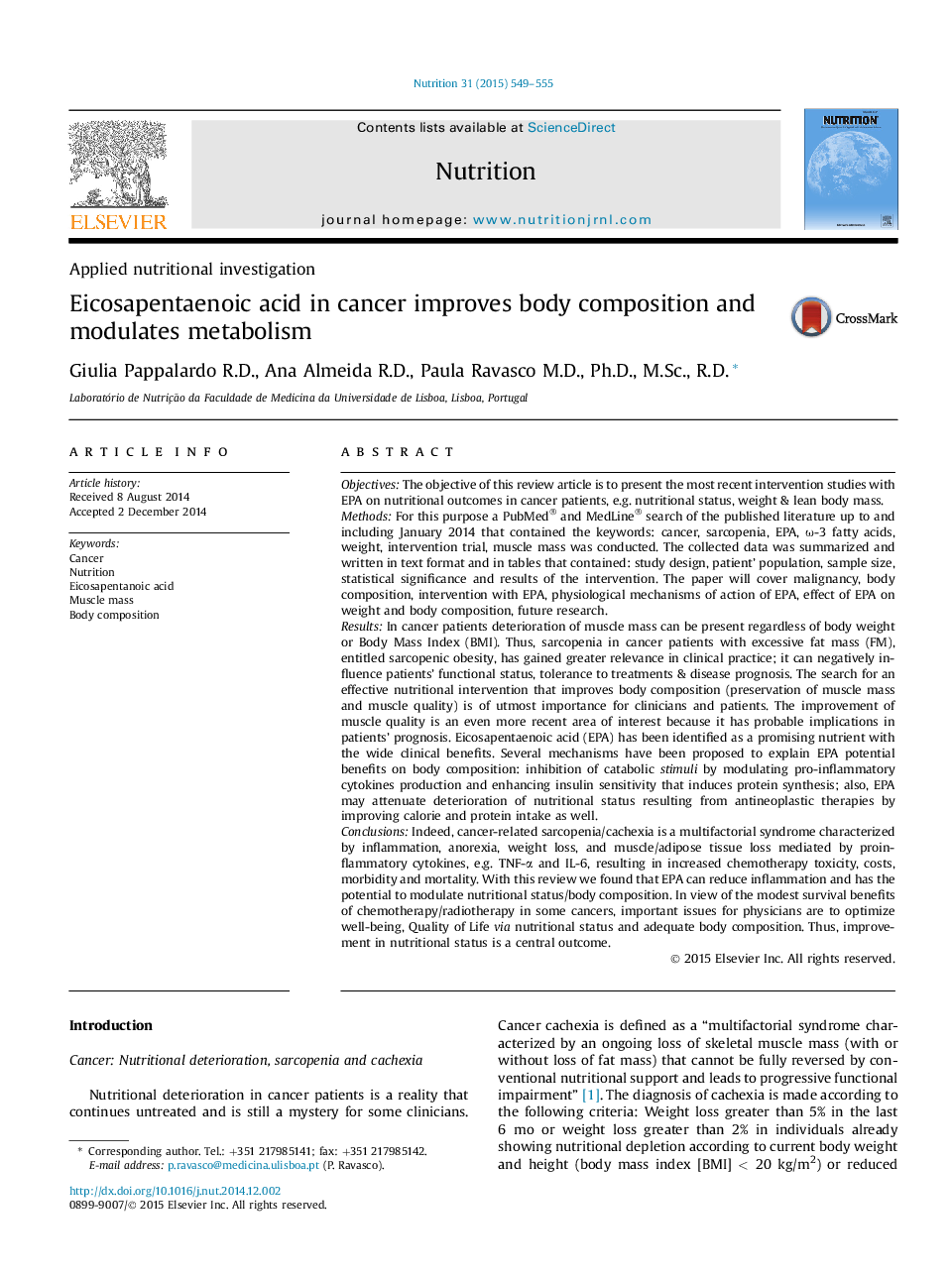| کد مقاله | کد نشریه | سال انتشار | مقاله انگلیسی | نسخه تمام متن |
|---|---|---|---|---|
| 3276223 | 1208539 | 2015 | 7 صفحه PDF | دانلود رایگان |
• Eicosapentaenoic acid (EPA) has potential antiinflammatory effects with influences on weight and reduce the rate of weight loss and lean body mass;
• After EPA supplementation, a reduction in C-reactive protein (CRP) concentration was found, as well as a stabilization of resting energy expenditure, the daily energy intake was significantly increased, and performance status and appetite improved.
• With EPA supplementation there was a higher EPA content in plasma phospholipids that were negatively correlated with inflammatory markers, e.g., interleukin-6 and CRP. There was a significant improvement in quality-of-life dimensions, namely physical and cognitive functions, global health status and social function, and a higher physical.
• EPA supplements in non-small cell lung cancer patients during chemotherapy, computed tomography scan images showed the quantity and quality of muscle mass (skeletal muscle index and muscle attenuation); there was a reduction in muscle and fat tissue wasting, resulting in the maintenance of weight and muscle mass during chemotherapy. Muscle fat infiltration assessed with skeletal muscle attenuation showed at the end of treatment, EPA reduced muscle attenuation indicating an increase in muscle fat infiltration.
• It is strongly advocated that EPA has a synergic effect with several chemotherapy agents. The mechanisms for these effects are not clear but may be associated with increased lipid peroxidation, tumor cell susceptibility to apoptosis, drug uptake or enhanced drug activation and diminished angiogenesis and metastasis. If all these clinical outcomes improve, body composition improves, as well as phase angle indicating improved cellularity.
ObjectivesThe objective of this review article is to present the most recent intervention studies with EPA on nutritional outcomes in cancer patients, e.g. nutritional status, weight & lean body mass.MethodsFor this purpose a PubMed® and MedLine® search of the published literature up to and including January 2014 that contained the keywords: cancer, sarcopenia, EPA, ω-3 fatty acids, weight, intervention trial, muscle mass was conducted. The collected data was summarized and written in text format and in tables that contained: study design, patient' population, sample size, statistical significance and results of the intervention. The paper will cover malignancy, body composition, intervention with EPA, physiological mechanisms of action of EPA, effect of EPA on weight and body composition, future research.ResultsIn cancer patients deterioration of muscle mass can be present regardless of body weight or Body Mass Index (BMI). Thus, sarcopenia in cancer patients with excessive fat mass (FM), entitled sarcopenic obesity, has gained greater relevance in clinical practice; it can negatively influence patients' functional status, tolerance to treatments & disease prognosis. The search for an effective nutritional intervention that improves body composition (preservation of muscle mass and muscle quality) is of utmost importance for clinicians and patients. The improvement of muscle quality is an even more recent area of interest because it has probable implications in patients' prognosis. Eicosapentaenoic acid (EPA) has been identified as a promising nutrient with the wide clinical benefits. Several mechanisms have been proposed to explain EPA potential benefits on body composition: inhibition of catabolic stimuli by modulating pro-inflammatory cytokines production and enhancing insulin sensitivity that induces protein synthesis; also, EPA may attenuate deterioration of nutritional status resulting from antineoplastic therapies by improving calorie and protein intake as well.ConclusionsIndeed, cancer-related sarcopenia/cachexia is a multifactorial syndrome characterized by inflammation, anorexia, weight loss, and muscle/adipose tissue loss mediated by proinflammatory cytokines, e.g. TNF-α and IL-6, resulting in increased chemotherapy toxicity, costs, morbidity and mortality. With this review we found that EPA can reduce inflammation and has the potential to modulate nutritional status/body composition. In view of the modest survival benefits of chemotherapy/radiotherapy in some cancers, important issues for physicians are to optimize well-being, Quality of Life via nutritional status and adequate body composition. Thus, improvement in nutritional status is a central outcome.
Journal: Nutrition - Volume 31, Issue 4, April 2015, Pages 549–555
